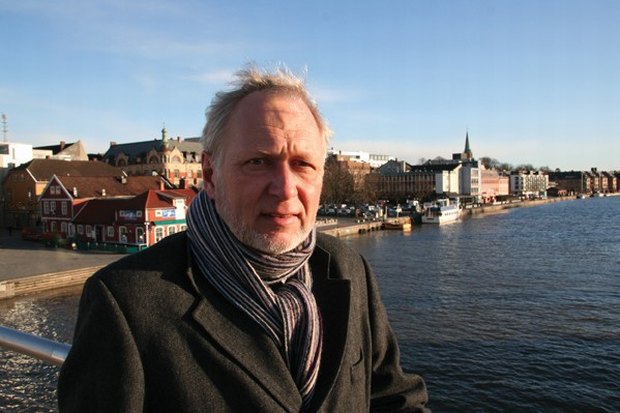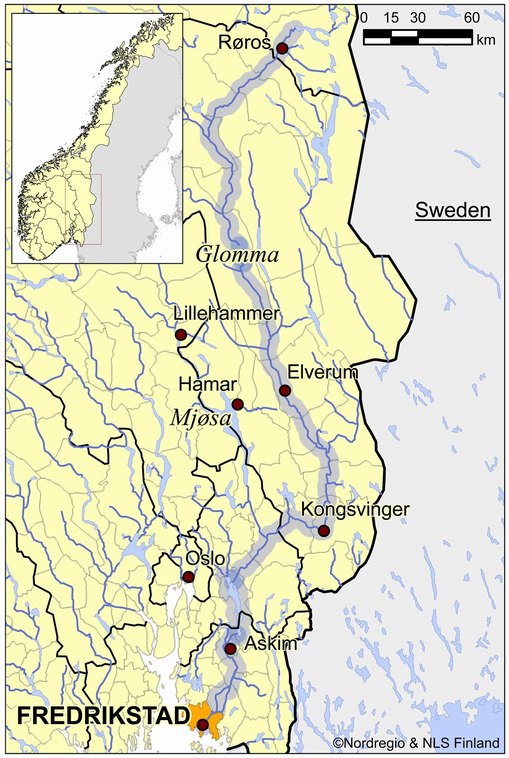
Rolf Petter Heidenstrøm with central Fredrikstad behind him. Extreme tides will easily put many of the town's streets under water. Photo: Odd Iglebaek
Fredrikstad is located at the outlet of the Glomma, the largest river in Norway. Large parts of the town are not much more than one metre above the water level: - In 1995 we experienced one of the largest floods in modern history. Four thousand cubic-metres of water rushed downstream every second, and that is a lot of water, adds Heidenstrøm. But as there is a large dam at Sarpsborg, 10 km upstream, the water was kept under control, thus flooding has not been a huge problem for us, at least not so far, he adds.
- You are also facing the Skagerak and the ocean, what about high-tides or rising sea-levels? - So far we have seen levels close to 150 cm above sea-level, but it is likely that we could experience 206 cm by 2100. Therefore we have decided that all new buildings, places of habitation etc., should be located, at minimum, 250 cm above sea-level. This was predominantly an administrative decision.
- What we have however been struggling most with thus far, has in fact been sudden and heavy rains, explains Hedenstrøm. – On the 14th of August this year 70 mm fell in four and a half hours. That is the largest amount ever measured. We have a good drainage system in the town and most of the water runs quickly out to the sea, but the system is not designed to cope with precipitation on this scale. In other words, we will have to do a lot of upgrading in addition to conducting extraordinary repairs to cope with possible future scenarios of this kind.
- Perhaps the most problematic issue is what happens to many basements. This year we had flooding in the cellars of close to three hundred houses, again a record, and in fact the third time in one year that such incidents occurred. This has probably never happened on this level and with this frequency before.
- Of course this all has significant cost implications relating to repairs and basement clean up; luckily thus far the majority of the costs have been covered by the insurance companies as force majeur.
- In future however it is clear that such responsibilities will increasingly be placed on the municipal authorities. This we have to be prepared for. We are also constantly working together with national, regional and local authorities to improve routines and planning regulations. Things seem to be moving steadily forward, with the exception of the regional authorities, who I guess have some catching-up to do, suggests Heidenstrøm.
Fredrikstad has 72 000 inhabitants of whom close to 30 000 live in urban areas and more than 40 000 in countryside. The total area of the municipality is 283 km2.
The local topography is a combination of smaller water bodies, woods, fields and low hills, predominantly of granite. Through the ice-ages the hills have been polished smooth and today hardly rise more than 50 metres above sea level. The land rises with approximately 8 mm every year
An archipelago, consisting of more than one thousand large and small islands, very popular for summer-recreation visits, is an important part of the municipality.
Fredrikstad was founded 1567, originally as a military fortress. During the 19th century the town was a major harbour for timber-export. Growth continued into the 20th century and major industries were developed including shipbuilding.
At present the shipyards are being transformed into new housing develop-
ments, as well as educational, business and recreational facilities. The town however retains many factories, particularly in the food-processing and the chemical industries.

Fredrikstad at the outlet of Glomma in southern Norway.
By Odd Iglebaek